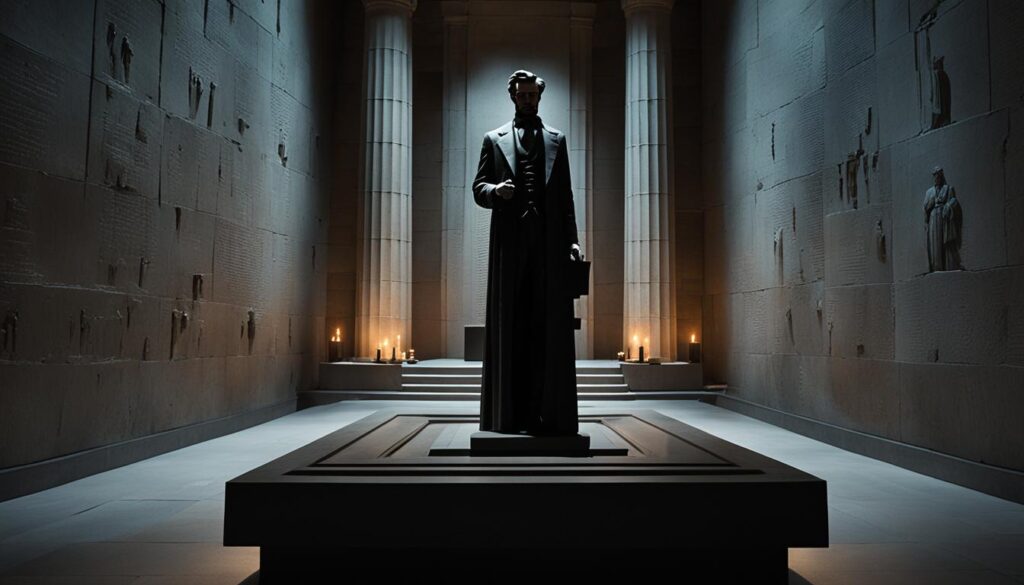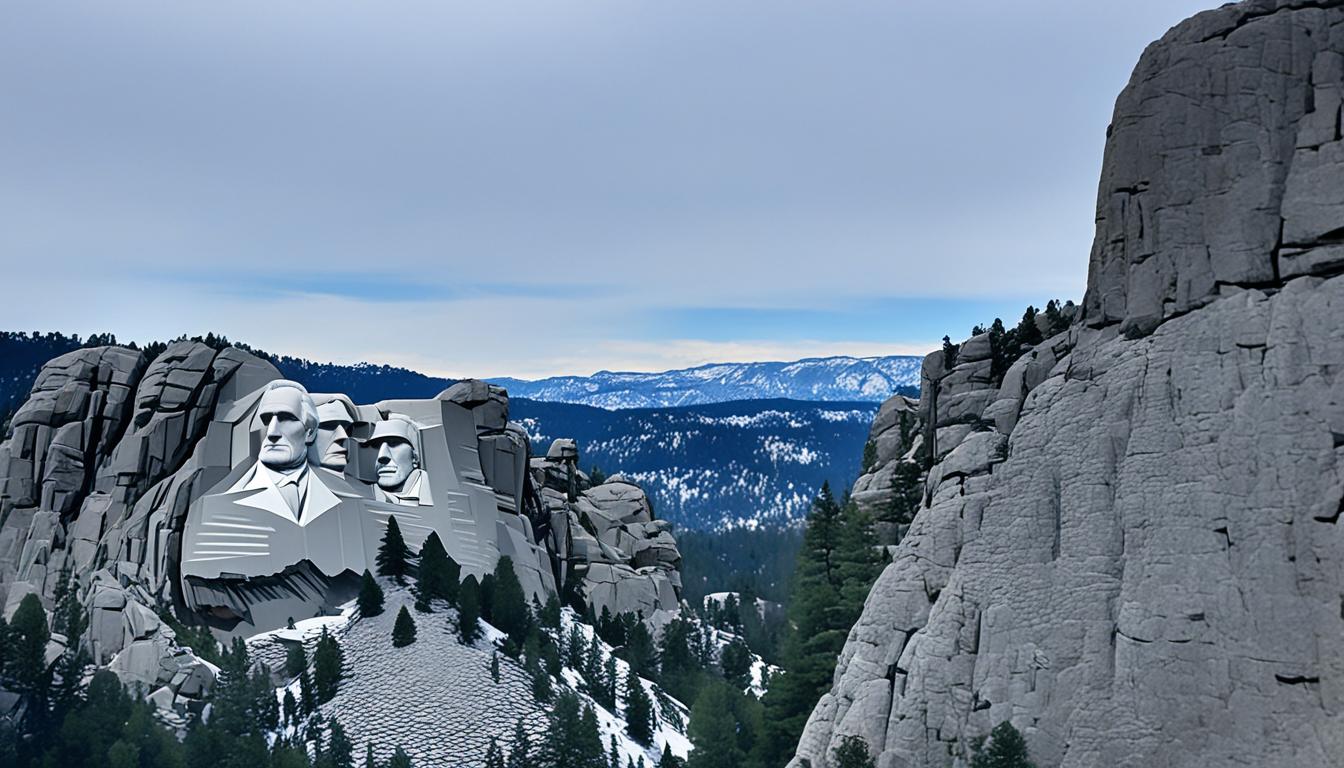Mount Rushmore, the colossal sculpture featuring the faces of four illustrious American presidents, harbors an intriguing secret hidden behind Abraham Lincoln’s head. Gutzon Borglum, the visionary sculptor behind this monumental work, had ambitious plans to create a grand “Hall of Records” within the depths of the mountain. This chamber was intended to serve as a repository for significant American documents and artifacts, preserving them for future generations.
The construction of the 70-foot tunnel leading to the Hall of Records commenced in 1938, but unfortunately, the project was abruptly halted in 1939 due to inadequate funding and the untimely death of Borglum in 1941. As a result, the unfinished chamber remains shrouded in mystery, inaccessible to the general public and known only to a select few authorized personnel.
The history of Mount Rushmore is intertwined with this fascinating secret room, adding an extra layer of intrigue to an already captivating national monument. The existence of the Hall of Records offers a glimpse into Borglum’s unfulfilled vision and the untold stories that lie within the heart of the mountain.
Key Takeaways
- Mount Rushmore conceals a secret room known as the Hall of Records behind Abraham Lincoln’s head
- Sculptor Gutzon Borglum envisioned the chamber as a repository for important American documents and artifacts
- Construction on the 70-foot tunnel began in 1938 but was halted in 1939 due to funding issues and Borglum’s death in 1941
- The unfinished Hall of Records remains inaccessible to the public, adding an element of mystery to Mount Rushmore’s history
- The secret room offers insight into Borglum’s grand vision and the untold stories within the mountain
The Unfinished Vision of Gutzon Borglum
Gutzon Borglum, the visionary sculptor behind the iconic Mount Rushmore National Memorial, had grand plans that extended far beyond the four presidential faces we see today. His original Mount Rushmore plans included a massive inscription detailing the history of the Louisiana Purchase and an ambitious chamber known as the “Hall of Records.” This hidden room was intended to serve as a repository for America’s most cherished documents and artifacts, preserving them for future generations.
Borglum’s vision for the Hall of Records was to create a testament to the nation’s rich history and remarkable achievements. He envisioned a grand chamber adorned with busts of prominent Americans and intricate inscriptions chronicling the country’s journey. The Hall of Records’ purpose was to safeguard priceless items such as the Declaration of Independence, the U.S. Constitution, and other significant works that shaped America’s identity.
However, Gutzon Borglum’s untimely death in 1941, coupled with financial constraints, left the Hall of Records unfinished. Despite the sculptor’s meticulous planning and tireless efforts, only a partial tunnel was blasted into the rock behind Abraham Lincoln’s head, leaving the grand vision incomplete. The unfinished nature of the Hall of Records serves as a reminder of the immense scale and ambition of Borglum’s original design for Mount Rushmore.
Although the Hall of Records remains unfinished, it stands as a testament to Gutzon Borglum’s unwavering dedication and the monumental scope of his vision for Mount Rushmore. The incomplete chamber behind Lincoln’s head offers a glimpse into the untold story of the memorial’s creation and the untapped potential that lies within the mountain. Borglum’s legacy endures through the awe-inspiring sculpture that captivates millions of visitors each year, even as his full vision remains an intriguing mystery waiting to be discovered.
Exploring the Chamber Behind Lincoln’s Head
Hidden behind the colossal sculpture of Abraham Lincoln’s head on Mount Rushmore lies a fascinating secret: the Mount Rushmore hidden chamber. This unfinished room, known as the Hall of Records, is accessible through an 18-foot-tall doorway carved into the granite wall. The chamber stretches approximately 75 feet in length, with a soaring 35-foot-tall ceiling that adds to its grandeur.
Upon entering the Mount Rushmore secret room, visitors would be greeted by walls bearing the marks of dynamite blasting, a testament to the incredible effort that went into its creation. Red numbers, possibly painted by the monument’s designer, Gutzon Borglum, can be seen on the walls, serving as a guide for the removal of rocks during the construction process. While the original vision for the Hall of Records was never fully realized, the chamber remains an intriguing part of Mount Rushmore’s history.

In 1998, the Borglum family successfully campaigned to have a scaled-down version of the Hall of Records installed within the unfinished chamber. This installation consists of sixteen porcelain enamel panels inscribed with the text of important American documents, along with information about the monument’s creation and history. These panels were carefully sealed in a teak box and placed inside a titanium vault, ensuring their preservation for future generations. A granite capstone bearing a quote from Gutzon Borglum was placed over the opening, adding a touch of reverence to the Hall of Records location.
Despite the allure of the Mount Rushmore hidden chamber, visitors are not permitted to access the secret room due to safety and security concerns. This inaccessibility only adds to the mystery and intrigue surrounding the chamber, making it a captivating part of Mount Rushmore’s rich history. The Hall of Records stands as a testament to the vision and determination of those who sought to create a lasting tribute to America’s founding principles and the leaders who shaped the nation’s destiny.
Mount Rushmore’s Secret Room: A Message for Future Civilizations
The secret chamber behind Abraham Lincoln’s head on Mount Rushmore was not simply intended as a storage space. In fact, sculptor Gutzon Borglum envisioned the Hall of Records serving a much greater purpose: to communicate a message to future civilizations about America’s founding and growth. Borglum feared that over time, Mount Rushmore might become a mystery, its meaning and significance lost like many ancient wonders. The Hall of Records was conceived as an explanatory statement to ensure the monument’s enduring legacy.
Within this unfinished room, Borglum planned to detail the importance of the four presidents depicted and highlight pivotal events that shaped the nation. Though inaccessible to the public, the installation of porcelain enamel panels in 1998 brought Borglum’s vision closer to realization. These panels help transform the Hall of Records into a Mount Rushmore time capsule, preserving a snapshot of American history.
While the secret room remains sealed, it stands as a testament to the enduring legacy of both America and Gutzon Borglum. The Hall of Records encapsulates the sculptor’s grand ambition to immortalize the nation’s story in stone, serving as an eternal message for generations to come. Through this chamber, Borglum sought to ensure that the monumental achievements etched into Mount Rushmore would endure, even if their original meaning faded with time.

Leave a Reply